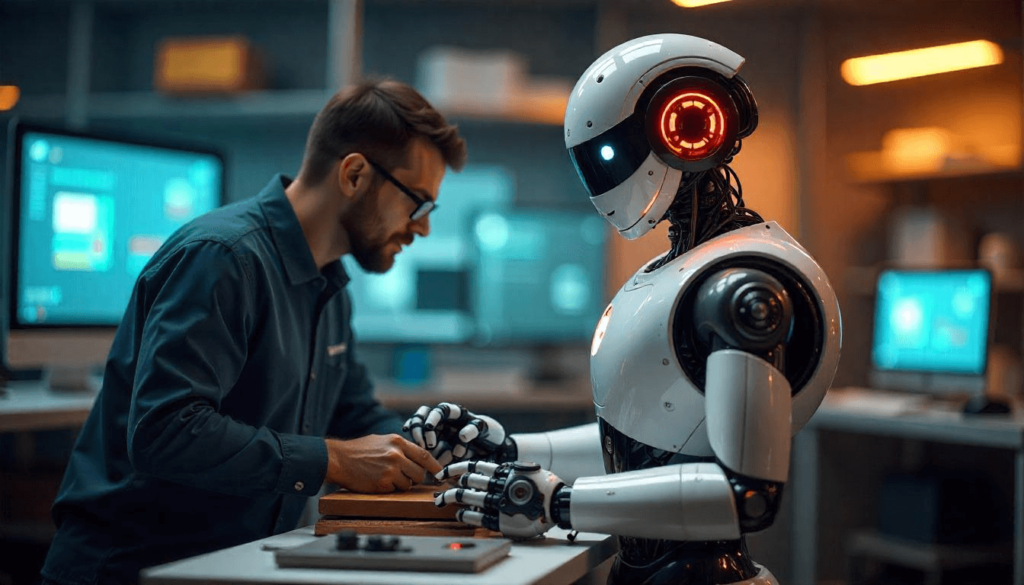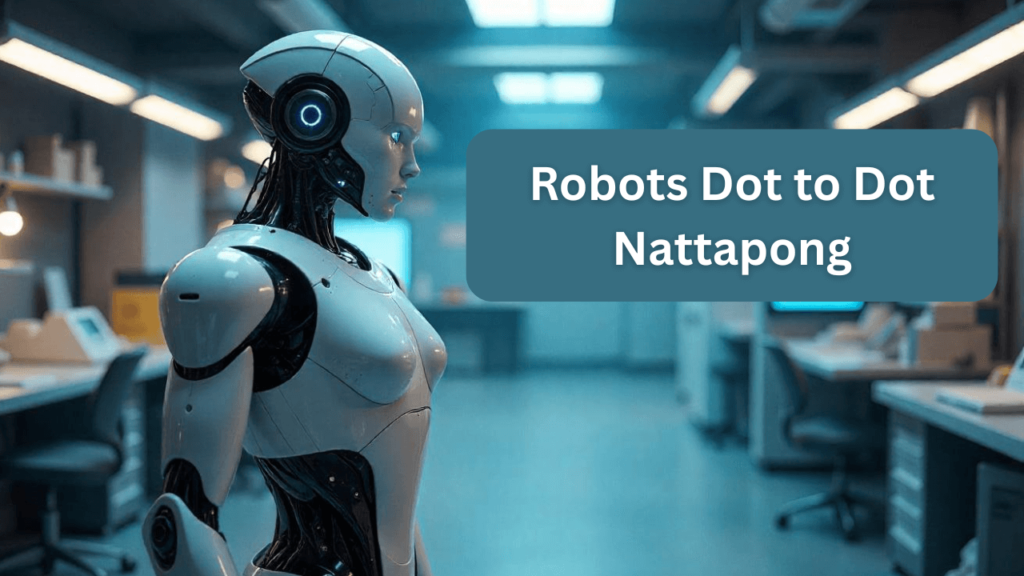The world of robotics is evolving rapidly, with innovations and new technologies making their way into various industries. One of the fascinating developments in this field is Robots Dot to Dot Nattapong, a concept that represents a fresh approach to robotic design and technology. In this blog, we will explore what makes Robots Dot to Dot Nattapong so significant and how it could potentially change the landscape of robotics. With advancements in artificial intelligence (AI), automation, and mechanical engineering, robots are becoming smarter, more efficient, and increasingly integrated into daily life. Understanding this technology and its potential applications will give you an insight into the future of robotics.
What is Robots Dot to Dot Nattapong?
Robots Dot to Dot Nattapong refers to a unique combination of robotic design principles and modern technological applications aimed at creating more advanced, flexible robots. This approach focuses on connecting different components and systems, allowing for smoother interactions between hardware and software. It integrates sophisticated AI algorithms, modular design, and flexible mechanical structures that can be adapted for various tasks.
The “Dot to Dot” concept is symbolic of how different systems work together, like dots connected to form a cohesive structure. By focusing on flexibility, adaptability, and efficiency, Robots Dot to Dot Nattapong ensures that robots are not only capable of performing complex tasks but also learning and evolving based on their environment and the data they receive. This design philosophy is pivotal in shaping the next generation of intelligent machines.
Key Features of Robots Dot to Dot Nattapong
- Modular Design: This feature allows robots to be reconfigured for different tasks, making them more versatile and capable of performing a variety of functions without the need for complete redesign.
- AI Integration: With artificial intelligence, robots can make decisions in real-time, adapting to their surroundings and learning from experiences.
- Interconnectivity: Components within the robot are designed to communicate seamlessly with each other, allowing for smoother performance and enhanced efficiency.
- Energy Efficiency: Newer robots are designed to consume less power, making them more sustainable and suitable for long-term use in various industries.
These features make Robots Dot to Dot Nattapong a groundbreaking advancement in the field of robotics, providing solutions to challenges that were previously difficult to overcome.
How Robots Dot to Dot Nattapong is Changing Robotic Design

One of the primary goals of Robots Dot to Dot Nattapong is to enhance robotic design by making robots more intuitive, adaptable, and useful in a wider range of industries. Traditional robots often require specialized programming and are limited by rigid designs that prevent them from adapting to new environments or tasks. However, with this new approach, robots can be designed to be more dynamic, capable of adjusting their actions based on new information and situations.
The Role of AI in Design
Artificial intelligence plays a crucial role in this new approach to robotics. With the ability to process large amounts of data and make real-time decisions, robots can perform tasks that once required human intervention. AI allows robots to understand their environment, recognize patterns, and make autonomous decisions. This increases their efficiency and makes them suitable for a broader range of applications.
Modular Components for Flexibility
A significant aspect of Robots Dot to Dot Nattapong is its modular design. Traditional robots often have fixed parts that cannot be easily adjusted. With modularity, robots can be customized for specific tasks by simply swapping out components. This not only makes robots more adaptable but also reduces production costs by reusing components for different models.
Streamlined Communication Between Systems
Communication between the various systems within a robot is another key element of Robots Dot to Dot Nattapong. By creating interconnectivity between different robotic components, engineers can ensure that robots work in a more synchronized and efficient manner. Whether it’s the AI processing unit, motor controllers, or sensors, all components need to be able to communicate seamlessly for optimal performance.
Applications of Robots Dot to Dot Nattapong
The advancements made possible by Robots Dot to Dot Nattapong have far-reaching implications for multiple industries. Below are some key areas where these innovations are making an impact:
1. Manufacturing
Robots have been part of the manufacturing industry for decades, but with the advent of more adaptable designs like Robots Dot to Dot Nattapong, their potential has significantly increased. These robots can be used for more complex and precise tasks, such as assembly, quality control, and even packaging. With modular components, robots can be reconfigured quickly for different production lines, improving efficiency and reducing downtime.
2. Healthcare
In healthcare, robots are being used for surgery, patient care, and medical research. The flexibility provided by Robots Dot to Dot Nattapong allows for robots that can perform delicate operations, assist in physical rehabilitation, and even provide companionship to elderly patients. The use of AI also ensures that these robots can learn and adapt to the specific needs of patients, offering personalized care.
3. Agriculture
Robots designed with Robots Dot to Dot Nattapong principles can also be applied in agriculture. Tasks such as planting, monitoring crop health, and harvesting can be automated with robots that are capable of adapting to various environments and crops. Their energy efficiency makes them ideal for long-term use in vast agricultural fields.
4. Space Exploration
The modular design and adaptability of Robots Dot to Dot Nattapong could play a vital role in space exploration. Robots used in space missions can be easily reconfigured to perform different tasks, such as collecting data, repairing equipment, and even building structures. AI and interconnectivity ensure these robots can make autonomous decisions, crucial when operating in the extreme conditions of space.
Insights and Future Trends
The future of Robots Dot to Dot Nattapong is incredibly promising. With the continued evolution of AI and robotics, these systems will become more intelligent, efficient, and capable of handling a wider range of tasks. Moreover, as industries adopt these technologies, we are likely to see further innovation in robot design and functionality.
The Role of Collaboration in Robotic Development
Collaboration between robotics engineers, AI researchers, and industry leaders will be key to pushing the boundaries of Robots Dot to Dot Nattapong. By sharing knowledge and working together, these fields can help create robots that are smarter, more adaptable, and better suited to real-world applications.
Potential Challenges
Despite the incredible potential of Robots Dot to Dot Nattapong, there are challenges that still need to be addressed. The integration of AI into robotic systems can lead to ethical concerns, particularly around decision-making and autonomy. Additionally, the cost of developing these advanced robots can be prohibitive for smaller companies. However, as technology advances, these challenges will likely be overcome, leading to even greater applications and opportunities for innovation.
FAQs
What makes Robots Dot to Dot Nattapong different from traditional robots?
Robots Dot to Dot Nattapong focuses on flexibility, modular design, and AI integration. Unlike traditional robots with fixed functions, these robots can be reconfigured and adapt to new environments and tasks.
How does AI improve robotic performance?
AI allows robots to make decisions in real-time, adapt to new situations, and learn from their experiences, improving their efficiency and capabilities.
What industries benefit from Robots Dot to Dot Nattapong?
Industries such as manufacturing, healthcare, agriculture, and space exploration can benefit from the advancements offered by Robots Dot to Dot Nattapong.
Can these robots operate autonomously?
Yes, robots using Robots Dot to Dot Nattapong principles can operate autonomously, making decisions based on AI algorithms and real-time data.
Conclusion
Robots Dot to Dot Nattapong represents a significant leap forward in the world of robotics, combining cutting-edge design with the power of artificial intelligence and modularity. This approach not only enhances the functionality of robots but also ensures their adaptability and efficiency across various industries. From manufacturing to healthcare, agriculture, and even space exploration, the potential applications are vast and transformative. While challenges remain in terms of cost and ethical considerations, the future of Robots Dot to Dot Nattapong holds immense promise. As technology continues to evolve, the robots of tomorrow will be more capable, intelligent, and integrated into our everyday lives, ultimately making tasks easier and more efficient. The journey of robotics is just beginning, and Robots Dot to Dot Nattapong is paving the way for the next generation of intelligent machines.
To stay updated with the latest trends in robotics and technology, visit ScoopUpdates.com for comprehensive insights

